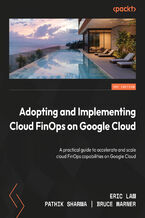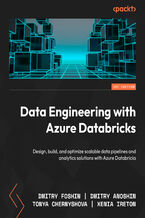
Microsoft Dynamics NAV. Implementing ERP Systems Alex Chow, Vjekoslav Babić, Laura Nicolas Lorente, David Studebaker, David Roys, Christopher Studebaker, Cristina Nicolas Lorente, Marije Brummel




- Autorzy:
- Alex Chow, Vjekoslav Babić, Laura Nicolas Lorente, David Studebaker, David Roys, Christopher Studebaker, Cristina Nicolas Lorente, Marije Brummel
- Wydawnictwo:
- Packt Publishing
- Ocena:
- Dostępne formaty:
-
PDFePubMobi
Opis
książki
:
Microsoft Dynamics NAV. Implementing ERP Systems
This course is a hands-on tutorial on working with a real Dynamics NAV implementation. It begins by providing an insight into the different tools available to migrate data from client legacy systems into Microsoft Dynamics NAV. If you are already live with Microsoft Dynamics NAV, you will learn about upgrades and what to expect from them. We’ll also show you how to implement additional or expanding functionalities within your existing Microsoft Dynamics NAV installation, perform data analysis, debug error messages, and implement free third-party add-ons to your existing installation. From here, you will be introduced to integrated development tools to make you a highly productive developer in the NAV environment.
The course will serve as a comprehensive reference guide, complementing NAV's Help files. You will find this course really useful if you want to evaluate Microsoft Dynamics NAV's development capabilities or need to manage NAV-based projects. Additionally, you will also learn about the NAV application structure, the C/SIDE development environment, the C/AL language, the construction and uses of each object type, and how it all fits together. Moving on, you will be guided through the NAV way of solving problems. You will be introduced to patterns and the software NAV architecture and will then build an example application. Then, you will walk through the details of architectural patterns, design patterns, and implementation patterns and will also learn about anti-patterns and handling legacy code. You will learn how to build solutions using patterns. The course offers premium, highly practical content on this recently released version of Dynamics NAV, and includes material from the following Packt books :
1. Implementing Microsoft Dynamics NAV - Third Edition
2. Programming Microsoft Dynamics™ NAV
3. Learning Dynamics NAV Patterns
Wybrane bestsellery
Alex Chow, Vjekoslav Babić, Laura Nicolas Lorente, David Studebaker, David Roys, Christopher Studebaker, Cristina Nicolas Lorente, Marije Brummel - pozostałe książki
Packt Publishing - inne książki
Dzięki opcji "Druk na żądanie" do sprzedaży wracają tytuły Grupy Helion, które cieszyły sie dużym zainteresowaniem, a których nakład został wyprzedany.
Dla naszych Czytelników wydrukowaliśmy dodatkową pulę egzemplarzy w technice druku cyfrowego.
Co powinieneś wiedzieć o usłudze "Druk na żądanie":
- usługa obejmuje tylko widoczną poniżej listę tytułów, którą na bieżąco aktualizujemy;
- cena książki może być wyższa od początkowej ceny detalicznej, co jest spowodowane kosztami druku cyfrowego (wyższymi niż koszty tradycyjnego druku offsetowego). Obowiązująca cena jest zawsze podawana na stronie WWW książki;
- zawartość książki wraz z dodatkami (płyta CD, DVD) odpowiada jej pierwotnemu wydaniu i jest w pełni komplementarna;
- usługa nie obejmuje książek w kolorze.
Masz pytanie o konkretny tytuł? Napisz do nas: sklep@helion.pl
Książka drukowana










































Oceny i opinie klientów: Microsoft Dynamics NAV. Implementing ERP Systems Alex Chow, Vjekoslav Babić, Laura Nicolas Lorente, David Studebaker, David Roys, Christopher Studebaker, Cristina Nicolas Lorente, Marije Brummel
(0)